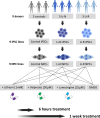Lithium increases mitochondrial respiration in iPSC-derived neural precursor cells from lithium responders
- PMID: 34075196
- PMCID: PMC8760072
- DOI: 10.1038/s41380-021-01164-4
Lithium increases mitochondrial respiration in iPSC-derived neural precursor cells from lithium responders
Abstract
Lithium (Li), valproate (VPA) and lamotrigine (LTG) are commonly used to treat bipolar disorder (BD). While their clinical efficacy is well established, the mechanisms of action at the molecular level are still incompletely understood. Here we investigated the molecular effects of Li, LTG and VPA treatment in induced pluripotent stem cell (iPSC)-derived neural precursor cells (NPCs) generated from 3 healthy controls (CTRL), 3 affective disorder Li responsive patients (Li-R) and 3 Li non-treated patients (Li-N) after 6 h and 1 week of exposure. Differential expression (DE) analysis after 6 h of treatment revealed a transcriptional signature that was associated with all three drugs and most significantly enriched for ribosome and oxidative phosphorylation (OXPHOS) pathways. In addition to the shared DE genes, we found that Li exposure was associated with 554 genes uniquely regulated in Li-R NPCs and enriched for spliceosome, OXPHOS and thermogenesis pathways. In-depth analysis of the treatment-associated transcripts uncovered a significant decrease in intron retention rate, suggesting that the beneficial influence of these drugs might partly be related to splicing. We examined the mitochondrial respiratory function of the NPCs by exploring the drugs' effects on oxygen consumption rate (OCR) and glycolytic rate (ECAR). Li improved OCR levels only in Li-R NPCs by enhancing maximal respiration and reserve capacity, while VPA enhanced maximal respiration and reserve capacity in Li-N NPCs. Overall, our findings further support the involvement of mitochondrial functions in the molecular mechanisms of mood stabilizers and suggest novel mechanisms related to the spliceosome, which warrant further investigation.
© 2021. The Author(s).
Conflict of interest statement
OAA is a consultant to HealthLytix and has received speaker’s honorarium from Lundbeck and Synovion. The other authors declare no conflict of interest.
Figures






Similar articles
-
Neural progenitor cells derived from lithium responsive and non-responsive bipolar disorder patients exhibit distinct sensitivity to cell death following methamphetamine.Neuropharmacology. 2023 Mar 15;226:109410. doi: 10.1016/j.neuropharm.2022.109410. Epub 2023 Jan 4. Neuropharmacology. 2023. PMID: 36608815
-
Mood stabilizers commonly restore staurosporine-induced increase of p53 expression and following decrease of Bcl-2 expression in SH-SY5Y cells.Prog Neuropsychopharmacol Biol Psychiatry. 2012 Aug 7;38(2):183-9. doi: 10.1016/j.pnpbp.2012.03.006. Epub 2012 Mar 29. Prog Neuropsychopharmacol Biol Psychiatry. 2012. PMID: 22484386
-
Transcriptional and functional effects of lithium in bipolar disorder iPSC-derived cortical spheroids.Mol Psychiatry. 2023 Jul;28(7):3033-3043. doi: 10.1038/s41380-023-01944-0. Epub 2023 Jan 18. Mol Psychiatry. 2023. PMID: 36653674 Free PMC article.
-
The Relationship Between Lithium and Cancer Proliferation: A Case-Based Review of the Literature.Curr Drug Metab. 2018;19(8):653-662. doi: 10.2174/1389200219666180430095933. Curr Drug Metab. 2018. PMID: 29708074 Review.
-
Genetic influences on response to mood stabilizers in bipolar disorder: current status of knowledge.CNS Drugs. 2013 Mar;27(3):165-73. doi: 10.1007/s40263-013-0040-7. CNS Drugs. 2013. PMID: 23378337 Free PMC article. Review.
Cited by
-
Mitochondrial dysfunction in psychiatric disorders.Schizophr Res. 2024 Nov;273:62-77. doi: 10.1016/j.schres.2022.08.027. Epub 2022 Sep 27. Schizophr Res. 2024. PMID: 36175250 Review.
-
Lithium compromises the bioenergetic reserve of cardiomyoblasts mitochondria.J Bioenerg Biomembr. 2025 Feb;57(1):27-38. doi: 10.1007/s10863-024-10050-x. Epub 2025 Jan 24. J Bioenerg Biomembr. 2025. PMID: 39849208 Free PMC article.
-
Lithium Enhances Hippocampal Glucose Metabolism in an In Vitro Mice Model of Alzheimer's Disease.Int J Mol Sci. 2022 Aug 5;23(15):8733. doi: 10.3390/ijms23158733. Int J Mol Sci. 2022. PMID: 35955868 Free PMC article.
-
Abnormalities in the migration of neural precursor cells in familial bipolar disorder.Dis Model Mech. 2022 Oct 1;15(10):dmm049526. doi: 10.1242/dmm.049526. Epub 2022 Oct 18. Dis Model Mech. 2022. PMID: 36239094 Free PMC article.
-
Lithium-Doped Titanium Dioxide-Based Multilayer Hierarchical Structure for Accelerating Nerve-Induced Bone Regeneration.ACS Appl Mater Interfaces. 2024 May 8;16(18):22887-22899. doi: 10.1021/acsami.4c01520. Epub 2024 Apr 25. ACS Appl Mater Interfaces. 2024. PMID: 38663861 Free PMC article.
References
-
- Schou M. Lithium prophylaxis in recurrent endogenous affective disorders. Arch Invest Med. 1972;3:459–72. - PubMed
-
- Yatham LN, Kennedy SH, Parikh SV, Schaffer A, Bond DJ, Frey BN, et al. Canadian Network for Mood and Anxiety Treatments (CANMAT) and International Society for Bipolar Disorders (ISBD) 2018 guidelines for the management of patients with bipolar disorder. Bipolar Disord. 2018;20:97–170. - PMC - PubMed
-
- Macritchie K, Geddes JR, Scott J, Haslam D, de Lima M, Goodwin G. Valproate for acute mood episodes in bipolar disorder. Cochrane Database Syst Rev. 2003;1:Cd004052. - PubMed
-
- Large CH, Di Daniel E, Li X, George MS. Neural network dysfunction in bipolar depression: clues from the efficacy of lamotrigine. Biochem Soc Trans. 2009;37:1080–4. - PubMed
Publication types
MeSH terms
Substances
LinkOut - more resources
Full Text Sources

